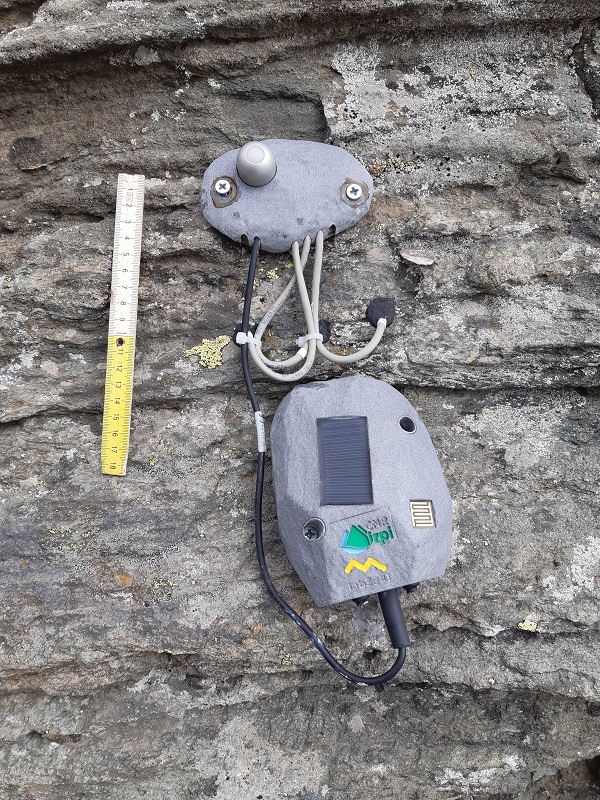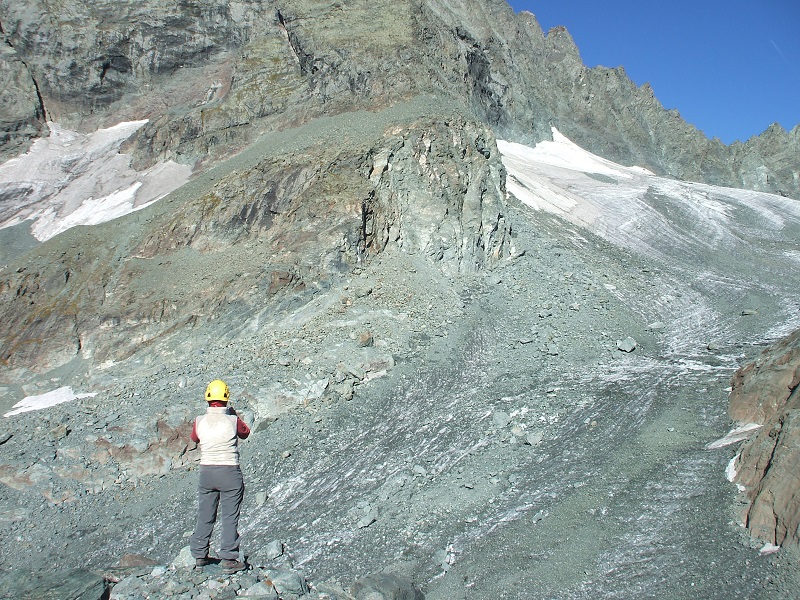Project 20223MKEMB_PE10_PRIN2022 - PNRR M4.C2.1.1
Rockfall risk mitigation in the Alps
Financed by the European Union - Next Generation EU

Focus
The first main focus of the project is the development of accurate and exportable heat transfer models of rock, specific for different lithotypes, to be used for risk mitigation in high-elevation rockfall-prone areas. The second main focus of the project is this web portal, created in order to make available, free of charge and in near real-time, the acquired, validated and modelled data.
The project will stem from the already-instrumented alpine area of the Bessanese glacial basin, which in the last 10 years has been the testbed of research on rockfall temperature monitoring, by innovative techniques, sensors and a strict cooperation with INRiM and CNR-IRPI.
State of the Art
In a context of a climate change that affects mountain cryosphere, landscapes are evolving and new hazards are emerging. Changes in mean and extreme air and rock temperature and precipitation values are important preparatory and triggering factors for slope instability in the mountain cryosphere (Deline et al., 2022). In particular, thermo-mechanical stresses due to air and rock temperature fluctuations induce crack opening or widening; permafrost degradation reduces rock strength (Krautblatter et al. 2013); diurnal and seasonal freeze/thaw cycles and, more in general, cycles of thermal expansion/contraction weaken rock slopes, predisposing them to failure (Matsuoka, 2019). In the last decades, an increase in natural instability processes – including rockfalls - affecting high-elevation mountain slopes has been documented and linked to climate warming (Fischer et al. 2012; Mourey et al. 2019). This trend can be ascribed to the cryosphere (including permafrost) degradation caused by air and rock temperature increase (Chiarle et al. 2015; Nigrelli et al. 2018; Nigrelli et al. 2021b).
Climate change is now an incontrovertible truth, but the relationship between air warming and rock temperature change is still little known. From a thermodynamic point of view, a complete modelling and understanding of heat transfer processes, associated temperature values and gradients in rocks exposed to radiative, convective, conductive and condensation forcing is highly complex. The thermal regime of the rock surface is very complex because is highly dependent on short- and longwave radiation, albedo, surface roughness, snow and vegetation cover and its distribution/variability in time and space. In order to better understand the effects of climate warming on slope instability in a context of cryosphere degradation, and apply appropriate risk mitigation actions, it would be necessary to have long-lasting, homogeneous rock temperature datasets, distributed throughout the Alps, to be analyzed in relation to the main geomorphological and meteorological parameters. However, this is difficult to do because:
- Long time series of rock temperature data, acquired in the mountain cryosphere of the Alps are rare;
- Where available, rock temperature data are often acquired by means of sensors and acquisition chains, for which measurement uncertainty is not always known and instrument traceability is often undocumented;
- Weather stations located in the mountain cryosphere of the Alps (specifically above 2500 m a.s.l.) are scarce.

Despite these problems, during the last 20 years several studies on rock temperature have been carried out in the Alps (Gruber et al. 2004; Viani et al. 2020). These studies highlight the importance of local studies in high-elevation experimental sites (Musacchio et al. 2021). The local scale approach through the availability of instrumented experimental areas allows to obtain precious information on relations between climate variability and thermal conditions of geological materials, necessary to better understand processes driving slope instability in the cryolithosphere. However, to take a step forward, two fundamental objectives need to be pursued, to improve data comparability in time and space:
- A constant check of data quality through the entire acquisition chain;
- The standardization of measurement techniques and methods.
A comprehensive understanding of heat transfer phenomena in rocks, of their thermophysical properties and thermal models are crucial to mitigate rockfall risk. In literature, several works based on the thermal characteristics of rocks for different lithotypes are available (Robertson, 1988). Wen et al. (2015) established temperature dependence of thermal conductivity, diffusion, and heat capacity for coal and rocks from coalfield. The numerical models to describe the heat transfer of rocks can be done considering a continuum (finite difference method and finite element method) or a discrete approach, and the choice of the methodology mainly depend on the problem scale and geometry and the dimension of the fracture (Jing and Hudson, 2002). Several publications investigate the heat transfer between fracture fluid and rock matrix, which is a function of lithotype, fracture aperture, surface roughness, and flow rate. Chen and Zhao (2020) provide a 3D heat transfer modelling of a rock fracture with heterogeneous apertures. Zhang and Xiang (2014) propose a semi-analytical approach to 3D heat transfer modelling in sparsely fractured rocks. The convective-conduction heat transfer processes in fractured rock mass were investigated by Xue et al. (2021) who compared two numerical simulations resulting from COMSOL and equivalent stationary principles, originating from three-dimensional equations.
Research Units, Roles, and Staff
Research Unit 1
Istituto Nazionale di Ricerca Metrologica (INRiM)
The role of this research unit is oriented towards metrological activities, both in laboratory and in field,
aimed at the selection, calibration, characterization and uncertainty budget evaluation of meteorological
and geological sensors - especially thermometers - that is used for the measurements planned and carried
over in the experimental sites.
Staff: Andrea Merlone, Graziano Coppa
Research Unit 2
Consiglio Nazionale delle Ricerche, Istituto di Ricerca per la Protezione Idrogeologica (CNR-IRPI)
The role of this research unit is specifically oriented towards field activities, where skills in the field
of geology, geomorphology, geo-hydrological risk and climatology are required. Field activities are carried
out mainly in the high-elevation experimental area of the CNR-IRPI, located in the Bessanese glacial basin,
as reported above. This research unit is also involved in identifying a second experimental area, which will
have to be located at high elevation in the western sector of the Italian Alps.
Staff: Guido Nigrelli, Marta Chiarle, Erica Matta
Research Unit 3
Politecnico di Torino, Dipartimento Energia (DENERG)
The role of this research unit is oriented to the development of a heat transfer model in different types of
rocks. This research unit characterizes the thermal behavior of rocks in terms of heat propagation as a
function of lithotype, air temperature, rock surface temperature, sunlight exposition, wind speed, depth and
mass of the rock wall. The information is used to create a numerical model that will be tested on others
experimental sites, in order to verify its portability and validate the results.
Staff: Vincenzo Corrado, Ilaria Ballarini, Seyed Amir Afzali Fatatouei
Project 20223MKEMB_PE10_PRIN2022 - PNRR M4.C2.1.1, Rockfall risk mitigation in the Alps, Financed by the European Union - Next Generation EU
